Per your request in comments, here's a more in-depth exploration. Consider the following screenshot (StackOverflow shrinks it for me -- it helps to look at it full size.):

What you're seeing here is 5 different drawing approaches (top to bottom) over three different backgrounds (left to right). (I've also dropped the fill alpha from 0.8 to 0.5 to make the effects easier to see.) The three different drawing approaches are (top to bottom):
- Just the stroke, not the fill, with a shadow
- The way you posted in the code in your original question
- The stroke and fill, with no shadow applied
- Just the shadow, by itself
- The way @DavidRönnqvist proposed in his answer.
The three different backgrounds should be self explanatory.
You said in your original question:
The first thing I notice, the shadow is only around the stroke.
This is why I included the first drawing approach. That's what it really looks like when there is just the stroke, with no fill, and (therefore) only the stroke is being shadowed.
Then, you said:
But that isn't the problem so far. The shadow behind the path/rect is
still visible, which means: the shadow color is effecting the fill
color of my path. The fill color should be white but instead its grey.
Your original code is the next version (#2). What you're seeing there is that the shadow for the stroke is darker than the shadow for the fill. This is because the stroke color's alpha is 1.0 and the fill's alpha is less than 1.0. This might be easier to see in version #4 which is just the shadow -- it's darker around the edge where the stroke is. Version #3 shows the drawing without a shadow. See you you can see the red and the image semi-obsurced in the fill of the shape? So in your original drawing you're seeing the object's own shadow through the object itself.
If that's not making sense, try thinking of a piece of glass that's got a tint to it (if you're into photography, think of a Neutral Density Filter). If you hold that glass between a light source and another surface, and then peek from the side and look just at the lower surface, you know that the semi-transparent glass is going to cast some shadow, but not as dark a shadow as something completely opaque (like a piece of cardboard). This is what you're seeing -- you're looking through the object at it's shadow.
Version #5 is @DavidRönnqvist's approach. The eye-fooling effect I was talking about in my comment is easiest to appreciate (for me, anyway) by looking at the shapes drawn over the image background. What it ends up looking like (in version #5) is that the shape is a bordered, copied, portion of the image that's been overlaid with a semi-transparent white mask of some sort. If you look back at version #3, it's clear, in the absence of the shadow, what's going on: you're looking through the semi-transparent shape at the image beneath. Then if you look at version #4, it's also clear that you have a shadow being cast by an object that's behind your eye/camera. From there, I would argue that that's also clear when looking at version #2 over the image what's going on (even if it's less clear over a solid color). At first glance, my eye/brain doesn't know what it's looking at in version #5 -- there's a moment of "visual dissonance" before I establish the mental model of "copied, masked, portion of the image floating above the original image."
So if that effect (#5) was what you were going for, then David's solution will work great. I just wanted to point out that it's sort of a non-intuitive effect.
Hope this is helpful. I've put the complete sample project I used to generate this screenshot on GitHub.

